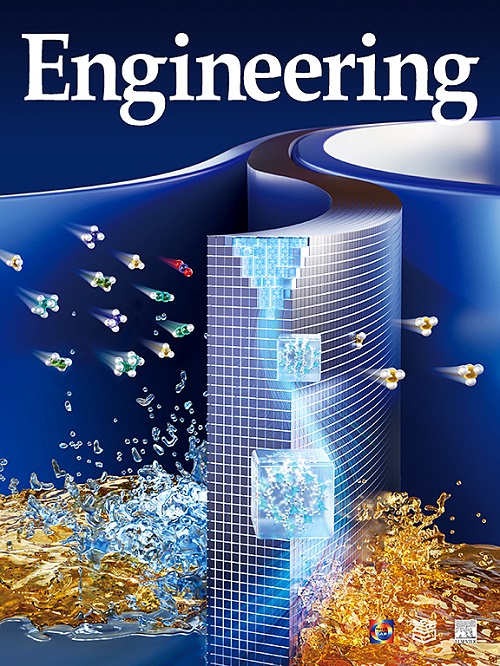通过孔几何拟合金属有机框架从裂解气中直接提纯乙烯
IF 10.1
1区 工程技术
Q1 ENGINEERING, MULTIDISCIPLINARY
引用次数: 0
摘要
从复杂的轻烃混合物中一步直接分离出聚合物级 C2H4 具有重要的工业意义,但却非常具有挑战性。本文采用乙烯吸附弱化策略精确调节了四种具有柱层结构的定制金属有机框架(MOFs)(命名为 TYUT-10/11/12/13)的孔几何形状。基于其孔隙几何设计和官能团调节,TYUT-12 对 C3H8、C3H6、C2H6、C2H2 和 CO2 的吸附选择性超过了 C2H4;其对 C2H6/C2H4 的吸附选择性达到了 4.56,超过了 Fe2(O2)(dobdc)(dobdc4- = 2,5-二氧代-1,4-苯二甲酸酯)的 4.4 记录值。中子粉末衍射测量和理论计算相结合,清楚地证明了 TYUT-12 中 C2H4 的弱π-π 堆积结合亲和力。突破性实验证明,可以直接从二元、三元、四元和六元轻烃混合物中获得 C2H4,纯度超过 99.95%。本文章由计算机程序翻译,如有差异,请以英文原文为准。
Direct Ethylene Purification from Cracking Gas via a Metal–Organic Framework Through Pore Geometry Fitting
The direct one-step separation of polymer-grade C2H4 from complex light hydrocarbon mixtures has high industrial significance but is very challenging. Herein, an ethylene-adsorption-weakening strategy is applied for precise regulation of the pore geometry of four tailor-made metal–organic frameworks (MOFs) with pillar-layered structures, dubbed TYUT-10/11/12/13. Based on its pore geometry design and functional group regulation, TYUT-12 exhibits exceptional selective adsorption selectivity toward C3H8, C3H6, C2H6, C2H2, and CO2 over C2H4; its C2H6/C2H4 adsorption selectivity reaches 4.56, surpassing the record value of 4.4 by Fe2(O2)(dobdc) (dobdc4− = 2,5-dioxido-1,4-benzenedicarboxylate). The weak π–π stacking binding affinity toward C2H4 in TYUT-12 is clearly demonstrated through a combination of neutron powder diffraction measurements and theoretical calculations. Breakthrough experiments demonstrate that C2H4 can be directly obtained from binary, ternary, quaternary, and six-component light hydrocarbon mixtures with over 99.95% purity.
求助全文
通过发布文献求助,成功后即可免费获取论文全文。
去求助
来源期刊

Engineering
Environmental Science-Environmental Engineering
自引率
1.60%
发文量
335
审稿时长
35 days
期刊介绍:
Engineering, an international open-access journal initiated by the Chinese Academy of Engineering (CAE) in 2015, serves as a distinguished platform for disseminating cutting-edge advancements in engineering R&D, sharing major research outputs, and highlighting key achievements worldwide. The journal's objectives encompass reporting progress in engineering science, fostering discussions on hot topics, addressing areas of interest, challenges, and prospects in engineering development, while considering human and environmental well-being and ethics in engineering. It aims to inspire breakthroughs and innovations with profound economic and social significance, propelling them to advanced international standards and transforming them into a new productive force. Ultimately, this endeavor seeks to bring about positive changes globally, benefit humanity, and shape a new future.
 求助内容:
求助内容: 应助结果提醒方式:
应助结果提醒方式:


